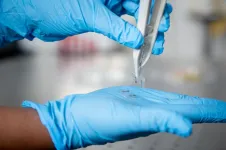(Press-News.org) Scientists create stable nanosheets containing boron and hydrogen atoms with potential applications in nanoelectronics and quantum information technology.
What's thinner than thin? One answer is two-dimensional materials -- exotic materials of science with length and width but only one or two atoms in thickness. They offer the possibility of unprecedented boosts in device performance for electronic devices, solar cells, batteries and medical equipment.
In collaboration with Northwestern University and the University of Florida, scientists from the U.S. Department of Energy's (DOE) Argonne National Laboratory report in Science magazine a breakthrough involving a 2D material called borophane, a sheet of boron and hydrogen a mere two atoms in thickness.
"We have tackled a significant challenge in determining the atomic structures from scanning tunneling microscopy images and computational modeling at the atomic scale with the help of computer vision." -- Argonne's Maria Chan, nanoscientist at the Center for Nanoscale Materials.
One of the most exciting developments in materials science in recent decades has been a 2D sheet of carbon (graphene), which is one atom thick and 200 times stronger than steel. A similarly promising and newer material is an atom-thick sheet of boron, called borophene -- with an "e." A multi-institutional team, including researchers in Argonne's Center for Nanoscale Materials (a DOE Office of Science User Facility), first synthesized borophene in 2015.
While graphene is simply one atomic layer out of the many same layers in the common material graphite, borophene has no equivalent parent structure and is very difficult to prepare. What's more, the rapid reaction of borophene with air means it is very unstable and changes form readily.
"Borophene by itself has all kinds of problems," said Mark Hersam, Professor of Materials Science and Engineering at Northwestern University. "But when we mix borophene with hydrogen, the product suddenly becomes much more stable and attractive for use in the burgeoning fields of nanoelectronics and quantum information technology."
The research team grew borophene on a silver substrate then exposed it to hydrogen to form the borophane. They then unraveled the complex structure of borophane by combining a scanning tunneling microscope with a computer-vision based algorithm that compares theoretical simulations of structures with experimental measurements. Computer vision is a branch of artificial intelligence that trains high performance computers to interpret and understand the visual world.
Even though the borophane material is only two atoms thick, its structure is quite complex because of the many possible arrangements for the boron and hydrogen atoms. "We have tackled a significant challenge in determining the atomic structures from scanning tunneling microscopy images and computational modeling at the atomic scale with the help of computer vision," said Argonne's Maria Chan, nanoscientist at the Center for Nanoscale Materials. Given the success in unraveling this complex structure, the team's automated analytical technique should be applicable in identifying other complex nanostructures in the future.
"What is really encouraging from our results is that we found a borophane nanosheet on a silver substrate to be quite stable, unlike borophene," said Pierre Darancet, nanoscientist at Argonne's Center for Nanoscale Materials. "This means it should be easily integrated with other materials in the construction of new devices for optoelectronics, devices combining light with electronics." Such light-controlling and light-emitting devices could be incorporated into telecommunications, medical equipment and more.
"These findings are an important step in realizing borophane's incredible potential as a two-dimensional material for nanoelectronics," Chan said.
INFORMATION:
The scientific paper reporting this work, entitled "Synthesis of borophane polymorphs through hydrogenation of borophene," appeared in Science. Authors are Q. Li, V.S.C. Kolluru, M.S. Rahn, E. Schwenker, S. Li, R.G. Hennig, P. Darancet, M.K.Y. Chan and M.C. Hersam.
This work was supported by the Office of Naval Research, the National Science Foundation, DOE Office of Basic Energy Sciences, and Laboratory Directed Research and Development funding from Argonne.
About Argonne's Center for Nanoscale Materials
The Center for Nanoscale Materials is one of the five DOE Nanoscale Science Research Centers, premier national user facilities for interdisciplinary research at the nanoscale supported by the DOE Office of Science. Together the NSRCs comprise a suite of complementary facilities that provide researchers with state-of-the-art capabilities to fabricate, process, characterize and model nanoscale materials, and constitute the largest infrastructure investment of the National Nanotechnology Initiative. The NSRCs are located at DOE's Argonne, Brookhaven, Lawrence Berkeley, Oak Ridge, Sandia and Los Alamos National Laboratories. For more information about the DOE NSRCs, please visit https://science.osti.gov/User-Facilities/User-Facilities-at-a-Glance.
Argonne National Laboratory seeks solutions to pressing national problems in science and technology. The nation's first national laboratory, Argonne conducts leading-edge basic and applied scientific research in virtually every scientific discipline. Argonne researchers work closely with researchers from hundreds of companies, universities, and federal, state and municipal agencies to help them solve their specific problems, advance America's scientific leadership and prepare the nation for a better future. With employees from more than 60 nations, Argonne is managed by UChicago Argonne, LLC for the U.S. Department of Energy's Office of Science.
The U.S. Department of Energy's Office of Science is the single largest supporter of basic research in the physical sciences in the United States and is working to address some of the most pressing challenges of our time. For more information, visit https://energy.gov/science.
How do we become a complex, integrated multicellular organism from a single cell?
While developmental biologists have long researched this fundamental question, Stanford University biologist and HHMI investigator Dominique Bergmann's recent work on the plant Arabidopsis thaliana has uncovered surprising answers.
In a new study, published April 5 in Developmental Cell, led by Bergmann and postdoctoral scholar Camila Lopez-Anido, researchers used single-cell RNA sequencing technologies to track genetic activity in nearly 20,000 cells as they formed the surface and inner parts of an Arabidopsis leaf. Through this highly detailed technique, the researchers captured ...
PHILADELPHIA - A team led by scientists at the Perelman School of Medicine at the University of Pennsylvania has illuminated the functions of mysterious structures in cells called "nuclear speckles," showing that they can work in partnership with a key protein to enhance the activities of specific sets of genes.
The discovery, which will be published on April 5 in Molecular Cell, is an advance in basic cell biology; the key protein it identifies as a working partner of speckles is best known as major tumor-suppressor protein, p53. This avenue of research may also lead to a better future understanding of cancers, and possibly better cancer treatments.
"This study shows that nuclear speckles work as major regulators of gene expression, and suggests that ...
UNIVERSITY PARK, Pa. -- Approximately 40,000 children in the United States may have lost a parent to COVID-19 since February 2020, according to a statistical model created by a team of researchers. The researchers anticipate that without immediate interventions, the trauma from losing a parent could cast a shadow of mental health and economic problems well into the future for this vulnerable population.
In the researchers' model, for approximately every 13th COVID-related death, a child loses one parent. Children who lose a parent are at higher risk of a range ...
CHICAGO - A new study shows that youth arrested as juveniles with psychiatric disorders that remain untreated, struggle with mental health and successful outcomes well beyond adolescence.
Research from Northwestern Medicine shows nearly two-thirds of males and more than one-third of females with one or more existing psychiatric disorders when they entered detention, still had a disorder 15 years later.
The findings are significant because mental health struggles add to the existing racial, ethnic and economic disparities as well as academic challenges from missed school, making a successful transition to adulthood harder to attain.
"Kids get into trouble during adolescence.Those from wealthier families also use drugs and get into fights. But these situations are most often ...
What The Study Did: Researchers estimated and projected the number of children in the United States affected by the death of a parent from COVID-19.
Authors: Rachel Kidman, Ph.D., of Stony Brook University in Stony Brook, New York, is the corresponding author.
To access the embargoed study: Visit our For The Media website at this link https://media.jamanetwork.com/
(doi:10.1001/jamapediatrics.2021.0161)
Editor's Note: The article includes conflict of interest disclosures. Please see the article for additional information, including other authors, author contributions and affiliations, conflict of interest and financial disclosures, and funding and support.
INFORMATION:
Media advisory: The full study is linked to this news release.
Embed this link to provide your readers ...
CLAREMONT, CA - Keck Graduate Institute (KGI) Assistant Professor and University of California, Berkeley Visiting Scientist Dr. Kiana Aran first introduced the CRISPR-Chip technology in 2019. Now just two years later, she has expanded on its application to develop CRISPR-SNP-Chip, which enables detection of single point mutations without amplification in Sickle Cell Disease and Amyotrophic lateral sclerosis (ALS).
"The field of CRISPR-based diagnostics is rapidly evolving due to CRISPR programmability and ease of use," Aran says. "However, the majority of CRISPR-based diagnostics platforms are still relying on target amplifications or optical detections. The reprogrammability of CRISPR combined with optics-free highly scalable graphene transistors will allow us to bring the ...
A new study, out this week, could pave the way to revolutionary, transparent electronics.
Such see-through devices could potentially be integrated in glass, in flexible displays and in smart contact lenses, bringing to life futuristic devices that seem like the product of science fiction.
For several decades, researchers have sought a new class of electronics based on semiconducting oxides, whose optical transparency could enable these fully-transparent electronics.
Oxide-based devices could also find use in power electronics and communication technology, reducing the carbon footprint of our utility networks.
A RMIT-led team has now introduced ultrathin beta-tellurite to the two-dimensional (2D) semiconducting material family, providing ...
Irvine, Calif. -- In 2019, the National Weather Service in Alaska reported spotting the first-known lightning strikes within 300 miles of the North Pole. Lightning strikes are almost unheard of above the Arctic Circle, but scientists led by researchers at the University of California, Irvine have published new research in the journal Nature Climate Change detailing how Arctic lightning strikes stand to increase by about 100 percent over northern lands by the end of the century as the climate continues warming.
"We projected how lightning in high-latitude boreal forests and Arctic ...
An interdisciplinary team led by KU Leuven and Stanford has identified 76 overlapping genetic locations that shape both our face and our brain. What the researchers didn't find is evidence that this genetic overlap also predicts someone's behavioural-cognitive traits or risk of conditions such as Alzheimer's disease. This means that the findings help to debunk several persistent pseudoscientific claims about what our face reveals about us.
There were already indications of a genetic link between the shape of our face and that of our brain, says Professor Peter Claes from the Laboratory for Imaging Genetics at KU Leuven, who is the joint senior author of the study with Professor Joanna Wysocka from the ...
Journal Name: Nature Methods
Title of the Article: Discovering multiple types of DNA methylation from individual bacteria and microbiome using nanopore sequencing
Corresponding Author: Gang Fang, PhD
Bottom Line:
Bacterial DNA methylation occurs at diverse sequence contexts and plays important functional roles in cellular defense and gene regulation. An increasing number of studies have reported that bacterial DNA methylation has important roles affecting clinically relevant phenotypes such as virulence, host colonization, sporulation, biofilm formation, among others.
Bacterial methylomes contain three ...



